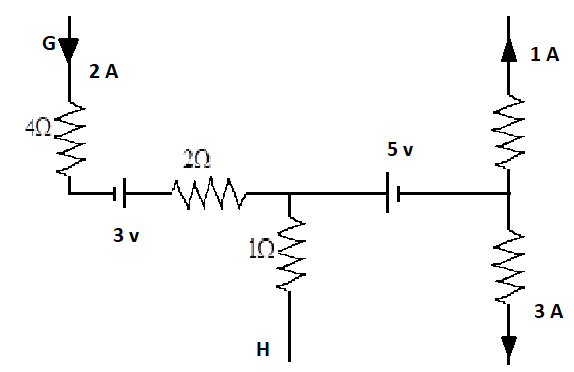
In the part of a circuit shown in figure, the potential difference (${V_G} - {V_H}$) between points G and H will be:

A) $0V$
B) $15V$
C) $7V$
D) $3V$
Answer
218.1k+ views
Hint: In order to solve this question, we have to remember all the concepts related to Kirchhoff’s current law, Kirchhoff’s voltage law and junction law. Kirchhoff’s current law is also known as Kirchhoff’s first law.
Complete step by step solution:
Kirchhoff’s current law (KCL) states that the total current or charge entering a node is equal to the charge leaving the node, as no charge is lost within the node.
Using Kirchhoff’s current law, we can have the current flowing through the $1\Omega $ resistor, which is $2A$ in the upward direction.

Now, On applying kirchhoff’s current law between points G and H, we have
${V_G} - 2 \times 4 + 3 - 2 \times 2 + 2 \times 1 - {V_H} = 0$
$ \Rightarrow {V_G} - {V_H} = 7V$
Therefore, by applying Krichhoff’s current law we get the potential difference (${V_G} - {V_H}$) between points G and H as $7V$.
Hence, the correct option is (C).
Additional Information: Kirchhoff’s circuit law has two laws:
Kirchhoff’s current law (KCL): This law states that the total current entering a node is equal to the current leaving the node. The algebraic sum of all the currents entering and leaving a node must be zero.
Kirchhoff’s voltage law: This law states that in a close loop, the total voltage in that close loop is equal to the sum of all the voltage drops in that same loop. This law deals with the conservation of energy.
Note: Always keep in mind that Kirchhoff’s current law deals with the conservation of current whereas Kirchhoff’s voltage law deals with the conservation of energy entering and leaving a node. Always write the answers in their SI units.
Complete step by step solution:
Kirchhoff’s current law (KCL) states that the total current or charge entering a node is equal to the charge leaving the node, as no charge is lost within the node.
Using Kirchhoff’s current law, we can have the current flowing through the $1\Omega $ resistor, which is $2A$ in the upward direction.

Now, On applying kirchhoff’s current law between points G and H, we have
${V_G} - 2 \times 4 + 3 - 2 \times 2 + 2 \times 1 - {V_H} = 0$
$ \Rightarrow {V_G} - {V_H} = 7V$
Therefore, by applying Krichhoff’s current law we get the potential difference (${V_G} - {V_H}$) between points G and H as $7V$.
Hence, the correct option is (C).
Additional Information: Kirchhoff’s circuit law has two laws:
Kirchhoff’s current law (KCL): This law states that the total current entering a node is equal to the current leaving the node. The algebraic sum of all the currents entering and leaving a node must be zero.
Kirchhoff’s voltage law: This law states that in a close loop, the total voltage in that close loop is equal to the sum of all the voltage drops in that same loop. This law deals with the conservation of energy.
Note: Always keep in mind that Kirchhoff’s current law deals with the conservation of current whereas Kirchhoff’s voltage law deals with the conservation of energy entering and leaving a node. Always write the answers in their SI units.
Recently Updated Pages
Arithmetic, Geometric & Harmonic Progressions Explained

Cartesian Form of Vector Explained: Formula, Examples & Uses

Apparent Frequency Explained: Formula, Uses & Examples

Calorimetry: Definition, Principles & Calculations

Centrifugal Force Explained: Definition, Formula & Examples

Charge in a Magnetic Field: Definition, Formula & Examples

Trending doubts
JEE Main 2026: Application Form Open, Exam Dates, Syllabus, Eligibility & Question Papers

Derivation of Equation of Trajectory Explained for Students

Hybridisation in Chemistry – Concept, Types & Applications

Understanding the Angle of Deviation in a Prism

Understanding Collisions: Types and Examples for Students

How to Convert a Galvanometer into an Ammeter or Voltmeter

Other Pages
JEE Advanced Marks vs Ranks 2025: Understanding Category-wise Qualifying Marks and Previous Year Cut-offs

Understanding Atomic Structure for Beginners

Ideal and Non-Ideal Solutions Explained for Class 12 Chemistry

Degree of Dissociation: Meaning, Formula, Calculation & Uses

Understanding Electromagnetic Waves and Their Importance

Understanding the Electric Field of a Uniformly Charged Ring




